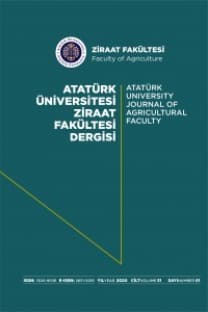Yem bitkilerinde allelopatik özellikler ve tarımsal ekosistemler üzerine etkileri
Allelopathy in forage crops and its effects on agroecosystems
___
- Bradow, J.M., Connick, W.J., 1990. Volatile seed germination inhibitors from plant residues. J. Chem. Ecol., 16:645-646.
- Chung, I.M., Miller, D.A., 1991. Autotoxic effects and re-seeding alfalfa. Agronomy Abst., ASA, Madisom, WI,p: 140.
- Chung, I.M., Miller, D.A., 1995 a. Differences in autotoxicity among seven alfalfa cultivars. Agron. J., 87:596-600.
- Chung, I.M., Miller, D.A., 1995 b. Allelopathic influence of nine forage grass extracts on germination and seedling growth of alfalfa. Agron. J., 87:767-772.
- Chung, I.M., Miller, D.A., 1995 c. Natural herbicide potential of alfalfa residue on selected weed species. Agron. J., 87:920-925.
- Dornbos, D.L., Spencer, G.F., Mite, R.W., 1990. Medicarpin delays alfalfa seed germination and seedling growth. Crop Sci., 30:162-166.
- Einhelling, F.A., 1996. Interaction involving allelopathy in cropping systems. Agron. J., 88: 886-893.
- Ells, I.E., McSay, A.E., 1991. Allelopathic effects of alfalfa plant residues on emergence and growth of cucumber seedlings. Hort. Sci., 26:368- 370.
- Guenzi, W.D., Kehr, W.D., McCalla, T.M., 1964. Water-soluble phytotoxic substances in alfalfa foliage; variation with variety, cutting, year and stage of growth. Agron. J., 56:499-500,
- Gussin, E. J., Lynch, J.M., 1981. Microbial fermentation of grass residues to organic acids as a factor in the establishment of new grass swank New Phytol, 89:449-457.
- Hall, M.H., Henderlong, P.R., 1989. Alfalfa autotoxic fraction characterization and initial separation. Crop Sci., 29:415-28,
- Hegde, R.S., Miller, DA, 1990. Allelopathy and autotoxicity in alfalfa: Characterization and effects of preceding crops and residue incorporation. Crop. Sci., 30:1255-1259.
- Jennings, J., 2001. Patience needed when replanting alfalfa after alfalfa. Hoarsd's Dairyman, April 25,2001, Fort Atkinson, WI.
- Jensen, E.H., Hartman, G.J., Lundin, F., Knapp, S., Brookerd, B., 1981. Autotoxicity in alfalfa. Nevada Agric. Exp. Stat. Report. R144.
- Luu, K.T., Matches, A.G., Peters, E.J., 1982. Allelopathic effects of tall fescue on birdsfoot trefoil as influenced by N fertilization and seasonal change. Agron. J., 74:805-808.
- McElğunn, J.D., Heinrichs, D.H., 1970. Effects of root temperature and a suspected phytotoxic substance on growth of alfalfa. Canadian J. Plant Sci., 50:307-311.
- McFarlane, M.J., Scott, D., Jarvis, P., 1982. Allelopathic effects of white clover. I. Germination and chemical bio-assay. New Zealand J. Agric. Res., 25:502-510.
- Miersch, J.C., Jülhlke, C, Sternkopf, G., Krauss, GJ., 1992. Metabolism and exudation of canavanine during development of alfalfa (Medicago saliva L. cv. Verbe). J. Chem. Ecol., 18:2117- 2129.
- Miller, DA, 1983. Allelopathic effects of alfalfa. J. Chem. Ecol., 9: 1059- 1072.
- Miller, D.A., 1992. Allelopathy in alfalfa and other forage crops. In Allelopathy: Basic and Applied Aspects, SJ.H. Rizvi, V. Rizvi (Eds.) Chapman-Hall, London, p: 169-177.
- Miller, D.A., 1996. Allelopathy in forage crop systems. Agron. X, 88: 854- 859.
- Miller, R.W., Kleiman, R., Powell, R.G., Putnam, A.R., 1988. Germination and growth inhibitors of alfalfa. J. Nat. Prod, 51: 328-330.
- Mishustin, E.N., Naumova, A.N., 1955. Secretion of toxic substances by alfalfa and their effect on cotton and soil microflora. tzvest. Akad. Nauk, SSSR, Ser. BioL, 6:3-9.
- Molisch, H., 1937. Der einer pflanze auf die andere - Allslopathie. Gustave Fischer Verlag, Jena
- Oleszek, W., Jurzysta, M., 1987. The allelopathic potential of alfalfa root: medicagenic acid glycosides and their fate in soil environments. Plant Soil, 98:67-80.
- Petersen, M.W., 1965. Effect of alfalfa saponin on cotton seed germination. Agron. J., 57: 516-517.
- Pester, T., 1998. Allelopathic effects of rye (Secale cereale L.) and their implications for weed management. Review Paper-En570 Spring 1998.
- Peterson, P., Sequin, P., Sheaffer, C.C., Schmit, M., Russelle, M., Randall, G., Hoverstad, T., Quiring, S., 2000. Autotoxicity during re-establishment of alfalfa - Is it a serious concern? Minnesota Forage Update. Fall, 2000 XXV (40, pp. 1-3) Minnesota Forage and Grassland Council, Minnesota, USA.
- Putnam, R.R., 1985. Weed allelopathy. In Weed Phsiplogy, S.O. Duke (Ed), CRC Press, Boca Raton, FL
- Rice, E.L., 1984. Allelopathy. Second Edition, Academic Press, New York, USA, 422 p. Ries, S.K., W. Wert, C.C. Sweerley, R.A. Leavit, 1977. Triacontanol: A new naturally occuring plant growth regulator. Science, 195, 1339. Seigler, D.S., 1996. Chemistry and mechanism of allelopathic interactions. Agron. J., 88:876-885.
- Ries, SJSL, Wert, W, Sweriey, GC, LeaviJ, RA, 1977. Triaoonlanol: A new nalutalfy auimngpkrtgtowthtegukfcr. Science, 195,1339.
- Stephenson, R.J., Peşler, G.L., 1988. The influence of tall fescue on the germination, seedling growth and yield of birdsfoot trefoil. Grass and Forage Sci., 43:273-278.
- Tesar, M.B., 1986. Re-establishing alfalfa without autotoxicity. Proc. Int. Symposium, Establishment of Forage Crops by Conservation Tillage Methods: Pest Management Methods. University Park, PA, 15-19 June 1986.
- Undersander, D.J., Martin, N.P., Cosgreve, D., Kelling, K., Schmitt, M., Wedberg, J., Becker, R., Grau, G, Doll, D., Rice, M.E., 1994. Alfalfa Management Guide. University of Wisconsin-Ext. Serv. Produced by Coop. Ext. USA
- Webster, G.R., Khan, S.U., Moore, A. W., 1967. Poor growth of alfalfa on some Alberta soils. Agron. J., 59:37-41.
- Weston, L.A., 1996. Utilization of allelopathy for weed management in agroecosystems. Agron. J., 88:860-866.
- White, R.H., Worsfaam, A.D., Blum, U., 1989. Allelopathie potential of legume debris and aqueous extracts. Weed Sci., 37:674-679.
- Yenish IP., Worsham, A.D., York, AC, 1996. Cover crops for herbicide replacement in no-tillage com (Zea mays). Weed Tecnnology, 10: 815-821.
- ISSN: 1300-9036
- Yayın Aralığı: 3
- Yayıncı: -
Erzurum ili Pasinler ilçesi tarımsal yapı ve mekanizasyon durumu
Estimation of population variance: A Ranke set sampling approach in a finite population setting
Balık işleme endüstrisinde modifiye atmosferde ambalajlama
Telat YANIK, Aras Şükriye HİSAR, Olcay HİSAR
